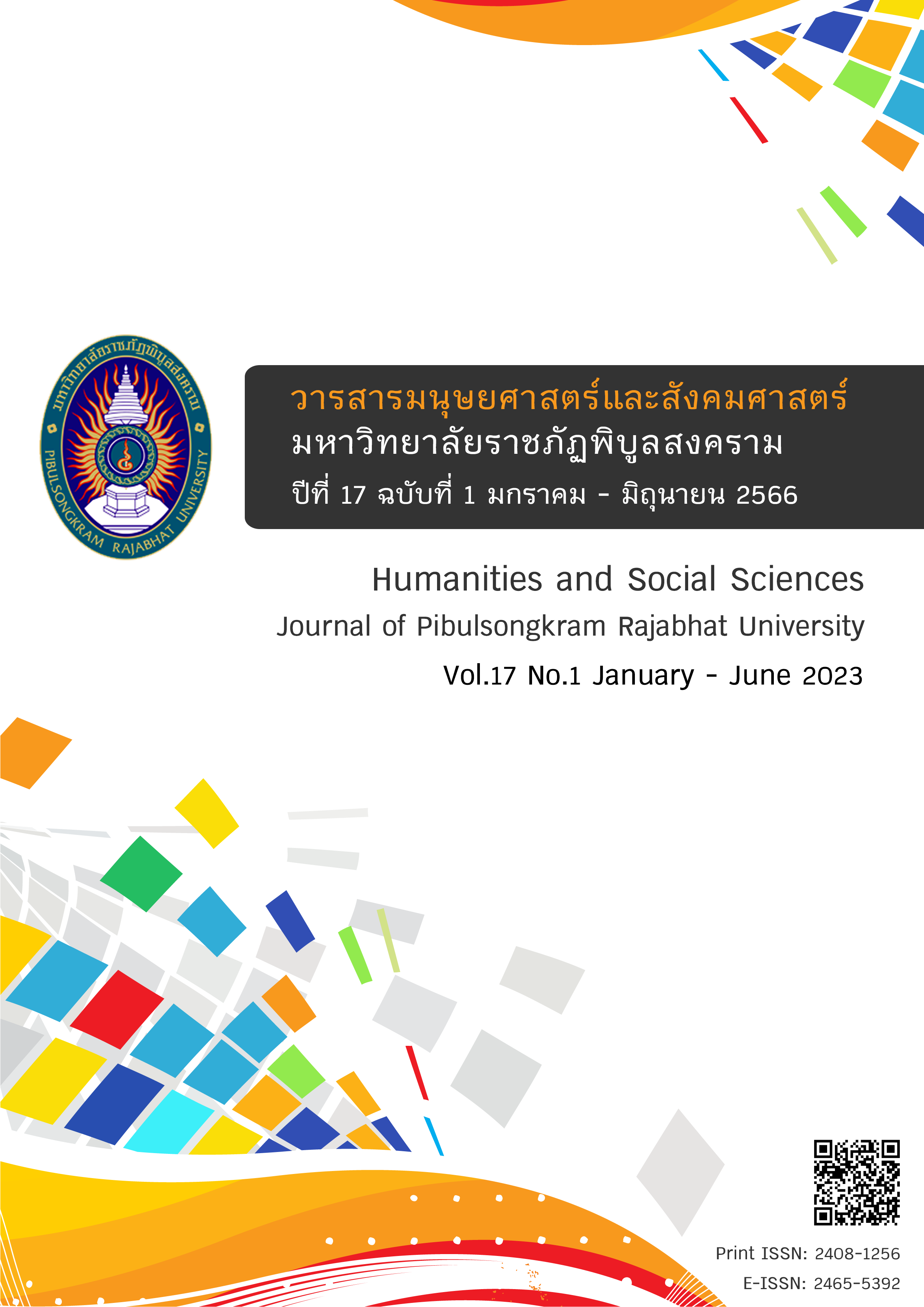The Innovation of Interpretation for Tourism through Eco-Museum
DOI:
https://doi.org/10.14456/psruhss.2023.11Keywords:
Innovation, Tourism interpretation, Eco-museumAbstract
The tourism interpretation plays an important role of success in tourism management of Thai tourism community. However, lacking of knowledge and know-how of tourism interpretation drives to study on 1) the innovation of interpretation for tourism through eco-museum 2) the tourist experiences perceived from the innovative interpretation for tourism through eco-museum in Thailand. The research employed the qualitative method. The data were collected by in-depth interview with eight representatives of government organizations and the eco-museum stakeholders, 19 local curators or local people and 18 tourists who visit three eco-museums in Trat Province such as Eco-museum of Yaimom Eco-museum of Taranae, and Eco-museum of Changtune. The data were also collected by the participatory observation on tourism activities in the three eco-museums. The findings were shown the innovative tourism interpretation through local curators, tourism activities, offline and online media. The innovative interpretation created the tourist experiences such as understanding, appreciation and consciousness towards community. The results can be applied in developing local tourism interpretation or other forms of tourism. The effective interpretation certainly leads to tourism pleasure and experiences with quality.
References
กรมการท่องเที่ยว กระทรวงการท่องเที่ยวและกีฬา. (2558). การสื่อความหมายในแหล่งท่องเที่ยว. กรุงเทพฯ: วี.ที.เค.พริ้นท์ติ้ง.
กรมพัฒนาชุมชน กระทรวงมหาดไทย. (2563). แผนปฏิบัติราชการระยะ 3 ปี (พ.ศ. 2563-2565) ของกรมพัฒนาชุมชน. สืบค้น 28 สิงหาคม 2563, จาก https://plan.cdd.go.th/cddplan3years
แก้วตา มุ่งเกษม, และสมพงษ์ อำนวยเงินตรา. (2558). การสื่อความหมายในแหล่งท่องเที่ยวเชิงนิเวศทางประวัติศาสตร์ทางวัฒนธรรม. กรุงเทพฯ: วี.ที.เค. พริ้นท์ติ้ง.
ชีวสิทธิ์ บุณยเกียรติ. (2551). พิพิธภัณฑ์บันทึก : ทบทวนบทเรียนจากการวิจัยและพัฒนาพิพิธภัณฑ์. กรุงเทพฯ: ศูนย์มานุษยวิทยาสิรินธร (องค์การมหาชน).
ณิศิรา กายราศ. (2557). นิเวศพิพิธภัณฑ์ โดยชุมชน แนวคิดใหม่เพื่อการท่องเที่ยวอย่างยั่งยืน. นครปฐม: รุ่งศิลป์การพิมพ์.
เดชา โควเอี่ยมไพโรจน์. (2561). พลิกโมเดลธุรกิจด้วยดิจิตอล: Transforming to a Digital Business. กรุงเทพฯ: DECHA. K.
ปารณีย์ ศรีสวัสดิ์, ณัฐกานต์ แน่พิมาย, เสาวภาคย์ สว่างจันทร์, และพงศ์เทพ แก้วเสถียร. (2562). การพัฒนานักสื่อความหมายท้องถิ่นเพื่อส่งเสริมการท่องเที่ยว ในอำเภอดอนสัก จังหวัดสุราษฎร์ธานี. วารสารวิชาการการท่องเที่ยวไทยนานาชาติ, 15(1), 157-162.
ราณี อิสิชัยกุล, และชัชพล ทรงสุนทรวงศ์. (2555). การท่องเที่ยวที่ไร้ความเร่งรีบเพื่อสร้างการเรียนรู้ ผ่านการสื่อความหมายสำหรับนักท่องเที่ยวสูงอายุชาวยุโรป. วารสารการบริการและการท่องเที่ยวไทย, 7(1), 41-57.
อรรถจักร์ สัตยานุรักษ์. (2545). นิเวศประวัติศาสตร์ : พรมแดนความรู้. กรุงเทพฯ: โครงการจัดพิมพ์คบไฟ.
Beck, L., & Cable, T. T. (2011). The Gifts of Interpretation: Fifteen Guiding Principles for Interpreting Nature and Culture (3rd ed.). Urbana, IL: Sagamore Publishing.
Birkner, Z., & Máhr, T. (2016). Interpreting innovation – in another way. Vezetéstudomány - Budapest Management Review, 47(10), 39-50.
Borrelli, N., & Davis, P. (2012). How Culture Shapes Nature: Reflections on Eco museum Practices. Nature and Culture, 7(1), 31-47.
Choi, S. S. (2016). A Study on Effect of Tourism Storytelling of Tourism Destination Brand Value and Tourist Behavioral Intentions. Indian Journal of Science and Technology, 9(46), 1-6.
David, P. (2011). New Museology, Communities, Ecomuseums (Lesson 5-7). Bangkok: Princess Maha Chakri Sirindhorn Anthropology Centre.
Eun, S. B. (2013). Eco-museum Project for Sustainable Rural Development. Seoul: Bookkorea Press.
Ham, S. H. (1992). Environmental Interpretation. Colorado. North American Press.
Hjalager, A. M. (2002). Repairing innovation defectiveness in tourism. Tourism Management, 23, 465-474.
Mossberg, L. (2007). A marketing Approach to the Tourist Experience. Scandinavian Journal of Hospitality and Tourism, 7(1), 59-74.
Nation Tourism Development Authority. (2016). Tourism Development & Innovation. A Strategy for Investment 2016-2022.
Rivière, G. H. (1985). The Ecomuseum: An Evolutive Definition. Museum International, 37(4), 182-183.
Saskatchewan, H. (2015). Ecomuseum Concept: A Saskatchewan Perspective on "museums Without Walls". Regina, SK: Heritage Saskatchewan and Museums Association of Saskatchewan.
Shin, H. (2006). A Study on the Peculiarities by Themes of Ecomuseums in Europe. Hankuk Nongchon Konchuk Hakhway Nonmunjib, 8(2), 8-11.
Silberman, N. A. (2008). The ICOMOS Charter for the Interpretation and Presentation of Cultural Heritage Sites. Retrieved September 6, 2020, from http://works.bepress.com/neil_silberman/21/
Tilden, F. (1977). Interpreting our Heritage. Chapel Hill: University of North Carolina Press.
Usui, M. (2009). นวัตกรรมการบริการ : เบื้องหลังความสำเร็จของเซเว่นอีเลฟเว่น เจแปนและธุรกิจบริการยุคใหม่ [Zukai Seven-Eleven ryu service innovation no joken] (ชไมพร สุธรรมวงศ์ และบัณฑิต โรจน์อารยานนท์, ผู้แปลและเรียบเรียง). กรุงเทพฯ: สมาคมส่งเสริมเทคโนโลยี (ไทย-ญี่ปุ่น).
Zhiyu, L. (2018). Innovation through interpretation: how judges make policy in China. Tulane journal of international and comparative law, 26(2), 327-380.
Downloads
Published
How to Cite
Issue
Section
License
Copyright (c) 2022 Humanities and Social Sciences Journal of Pibulsongkram Rajabhat University

This work is licensed under a Creative Commons Attribution-NonCommercial-NoDerivatives 4.0 International License.
Any articles or comments appearing in the Journal of Humanities and Social Sciences, Rajabhat Phibulsongkram University, are the intellectual property of the authors, and do not necessarily reflect the views of the editorial board. Published articles are copyrighted by the Journal of Humanities and Social Sciences, Rajabhat Phibulsongkram University.









